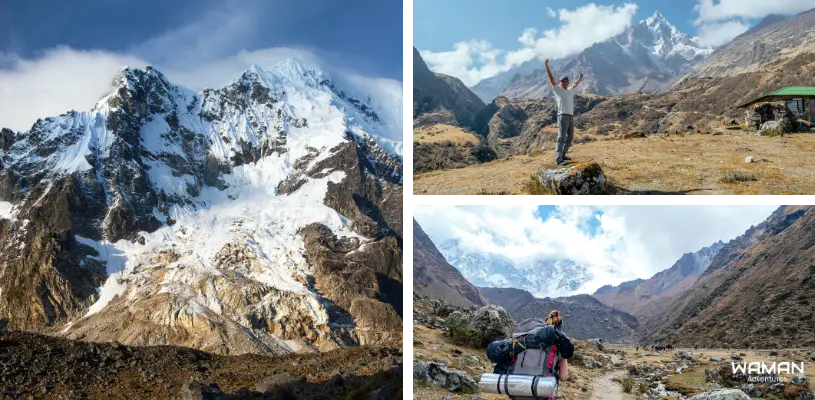OUR DEFINITIVE GUIDE TO CONQUER THE SALKANTAY TREK
Ultima actualización en 5 November, 2024 por Waman Adventures
Last Updated on 5 November, 2024 by Waman Adventures
Do you consider yourself an intrepid traveler seeking exciting experiences? The Salkantay trek is your option to immerse yourself in one of the most exciting hikes in the Peruvian Andes. This adventure towards Machu Picchu is less crowded and takes you through the authenticity of the Andes Mountain Range, linking the majesty of the mountains with the lushness of the rainforest.
Throughout this trek, you will witness breathtaking landscapes and enjoy the harmony that connects you deeply with Cusco and its traditions and biodiversity. It is also considered one of the top 25 treks in the world by National Geographic Adventures Travel. This trek offers an out-of-the-ordinary experience and enables you to explore Peru’s best-kept treasures as you approach Machu Picchu.
WHAT IS THE SALKANTAY TREK?
The Salkantay trek is a world-famous trekking route, ranking among the top 25 treks according to National Geographic.
- It is the best alternative to the Inca Trail to Machu Picchu, being a less crowded trek.
- It is named after the Salkantay Mountain.
- It features different biomass.
- It includes imposing mountains, turquoise lakes, and dense cloud forests.
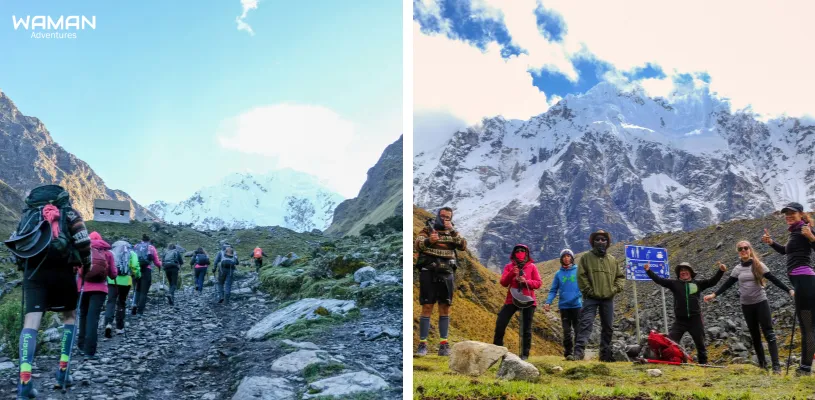
Tourists begin the Salkantay Trek towards Salkantay Pass
WHAT DOES SALKANTAY MEAN?
The word Salkantay is a Quechua word composed of:
- Sallqa or Salka means “wild” or “untamed”.
- Antay means “head” or “beak”.
So, Salkantay means “wild peak”.
WHERE IS THE SALKANTAY TREK?
The exciting Salkantay trek is in the Cusco region, in southern Peru. This impressive trekking route crosses the majestic Andes Mountain Range, specifically the imposing Vilcabamba Mountain Range.
WHERE THE SALKANTAY TREK BEGINS AND ENDS
Here are the 4 versions of the Salkantay trek, and its starting and ending points:
- The Salkantay trek to Machu Picchu in 5 days starts in Challacancha and culminates in Machu Picchu.
- The Salkantay trek to Machu Picchu in 4 days starts in Soraypampa and ends at Machu Picchu.
- The Salkantay + Inca Trail 7 days starts in Challacancha and culminates in the archaeological jewel, Machu Picchu.
- The Humantay Lake + Salkantay Pass in 2 days starts in Soraypampa and culminates in Soraypampa.
All the options mentioned above show you the Andes mountains and its impressive landscapes.
WHAT IS THE AVERAGE ALTITUDE DURING THE SALKANTAY TREK?
Throughout the Salkantay trek, you will hike through different altitudes, ascending or descending mountains throughout the trek. This characteristic is one of the challenges and excitements of the trek.
During the first stage, you will hike from Soraypampa (3,900 m/12,795 ft). As you progress, you’ll rise to higher altitudes, reaching high points such as the Salkantay Pass at 4,600m/15,092ft, before descending to cloud forest.
WHAT IS THE HIGHEST POINT ON THE SALKANTAY TREK?
The highest point reached during the Salkantay trail is the Salkantay pass at 4,630 m/15,190 ft approximately.
WHAT IS THE DISTANCE COVERED ON THE SALKANTAY TREK IN Kilometers?
Along the whole trail of the Salkantay Trek, 70 kilometers/43 miles are covered.
It is important to note that it is possible to shorten the total distance of the Salkantay trek by using means of transport or choosing different versions of this route, such as the Salkantay trek to Machu Picchu 4 days or the Humantay Lake 2 days. There is also the possibility of extending this adventure by combining the Salkantay trek + Inca Trail.
All the routes that the Andes has to offer in this cone are made up according to your preferences and needs.
HOW LONG DOES THE SALKANTAY TREK LAST?
The duration depends on the version you choose.
SALKANTAY TREK TO MACHU PICCHU 4 DAYS
Explore the Salkantay trek on an unforgettable 4-day adventure! This popular schedule allows you to experience the natural beauty of the Peruvian Andes and ends in Machu Picchu, one of the archaeological wonders of the world.
This trekking tour begins with the breathtaking view of Salkantay Mountain in Soraypampa. On the second day, you will cross the challenging Salkantay Pass. On the third day, you will explore deep into the cloud forest. Finally, on the fourth day, you will witness the enigmatic citadel of Machu Picchu.
- Distance covered: 52 km/32 mi.
- Travel time: Approximately 20 hours.
- Minimum altitude: 3,900 m/12,795 ft.
- Highest altitude: 4,630 m/15,190 ft.
- Difficulty: Tough
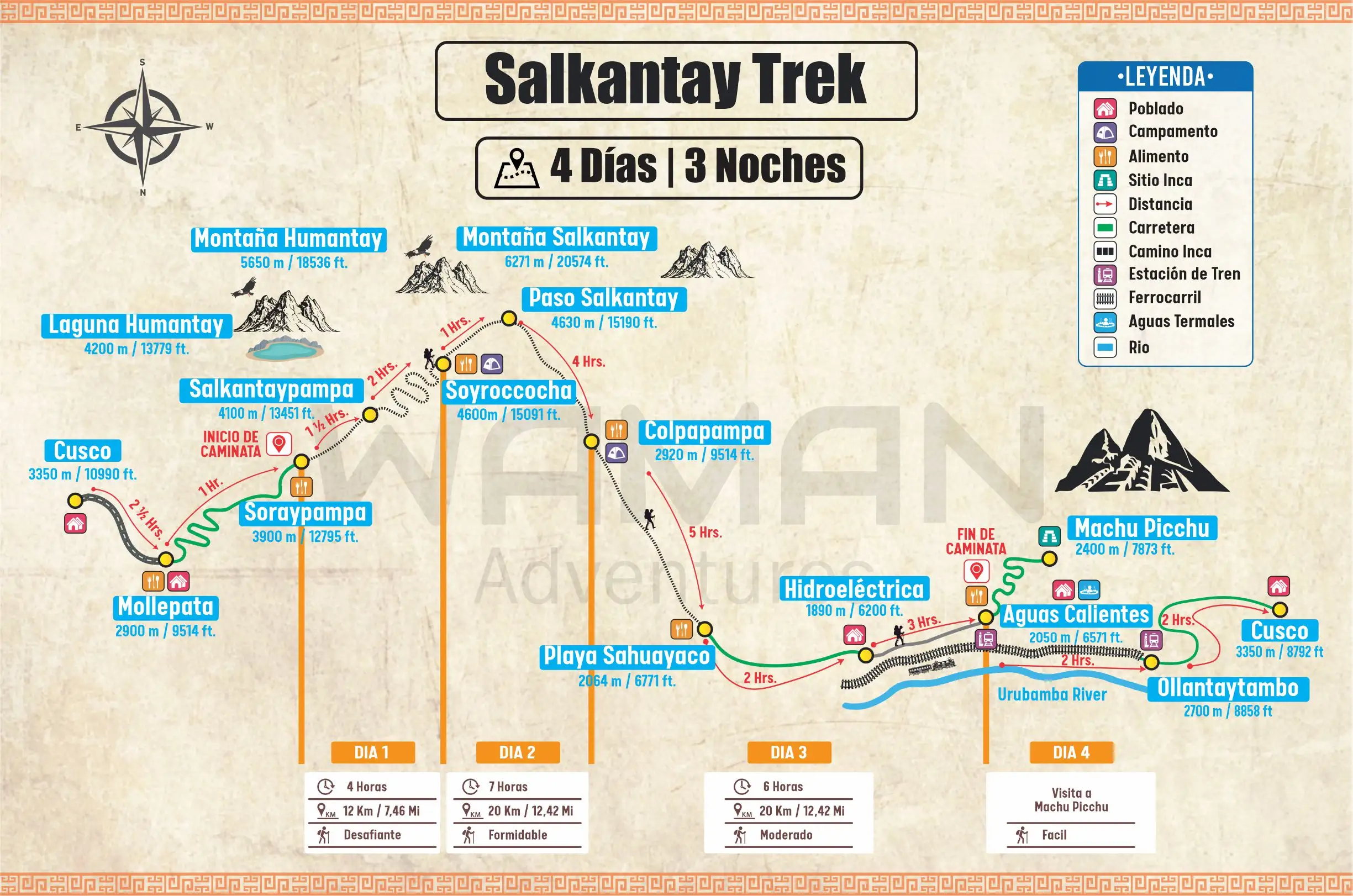
Illustrative map of the Salkantay trek 4 days/3 nights
SALKANTAY TREK TO MACHU PICCHU 5 DAYS
Discover this classic version of the Salkantay trail in 5 days while traversing breathtaking landscapes, crossing thick forests and mountain ranges. The views along the route are superb, and its surroundings change as you continue trekking.
The 5-day Salkantay trek isn’t just a hike; it is a life-changing experience. Throughout the trek, you will enjoy majestic views, explore breathtaking landscapes, cross the Salkantay Pass and immerse yourself in dense forests, until the amazing Machu Picchu on the last day,
- Distance covered: 70 km/43 mi.
- Trekking time: Approximately 26 hours
- Minimum altitude: 3,600 m/11,811 ft.
- Highest altitude: 4,630 m/15,190 ft.
- Difficulty: Challenging

Illustrative map of Salkantay trek to Machu Picchu 5 days/4 nights
HUMANTAY LAKE & SALKANTAY PASS 2 DAYS
The Humantay Lake hike is the best for those who wish to explore and witness high Andean lakes and altitudes. During this trek, you will be privileged with snow-capped Salkantay Mountain and Humantay Lake. Also, explore, in just 2 days, opportunities and challenges in one of the most beautiful and accessible treks in Cusco.
- Distance covered: 22 km/13 mi.
- Estimated travel time: 10 hours.
- Minimum altitude: 3,900 m/12,795 ft.
- Highest altitude: 4,630 m/15,190 ft
- Difficulty: Tough.
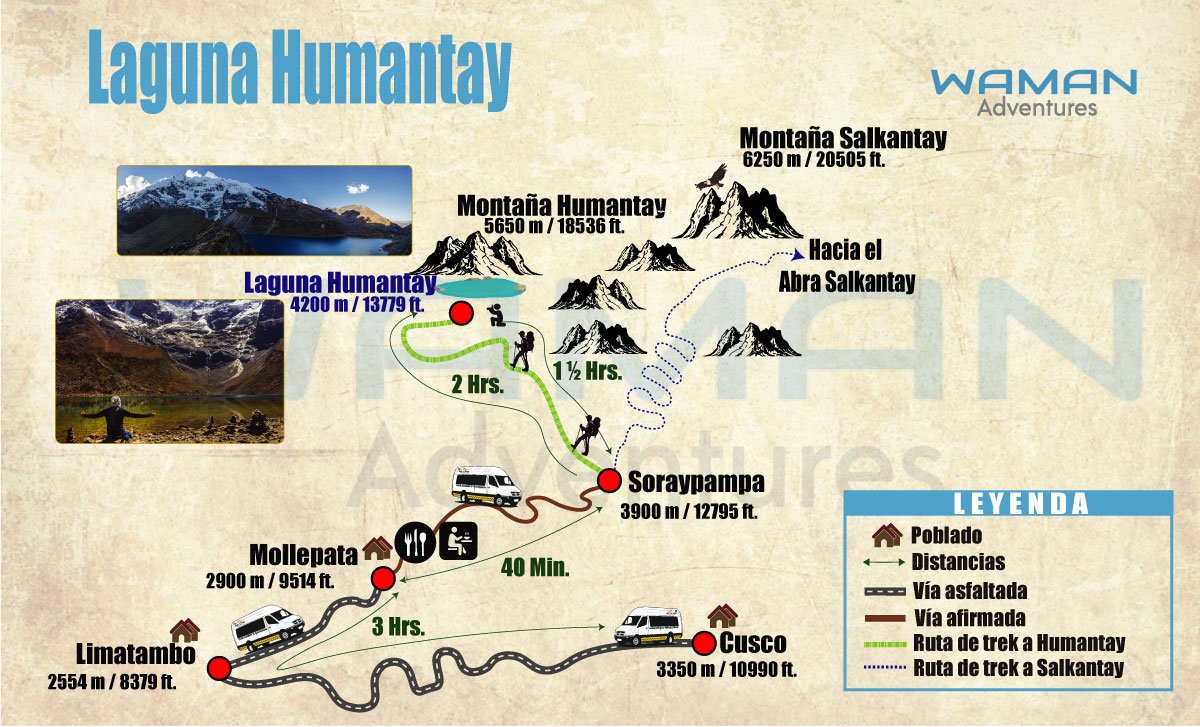
Map of the Humantay Lake & Salkantay Pass Trek 2 days/1 night
SALKANTAY TREK + INCA TRAIL TO MACHU PICCHU 7 DAYS
The Salkantay trek and Inca Trail in one trip! This exciting version is perfect for those who wish to experience two of Peru’s most famous trekking routes in one trek.
- Distance covered: 80 km/49 mi.
- Estimated trekking time: 39 hours.
- Minimum altitude: 2,680 m/8,792 ft.
- Highest altitude: 5,200 m/ 17,060 ft.
- Difficulty: Formidable.
HOW DIFFICULT IS THE SALKANTAY TREK?
The Salkantay trek is challenging.
The level of difficulty can be explained by the following factors:
- Altitude: The highest point is Salkantay Pass at 4,630 m/15,190 ft. Altitude can make breathing difficult and increase fatigue, especially for non-acclimatised people.
- Distance and duration: The Salkantay trek covers a considerable distance, generally around 70 – 78 kilometres (43 – 48 miles) throughout 4, 5 or 7 days, the latter in combination with the Inca Trail.
- Geography: It varies from well-maintained roads to steep, rocky trails, which can be challenging in some sections.
- Weather: Weather conditions are unpredictable in the Andes region during the rainy season. During the trek, rain and cold temperatures add difficulty to this adventure.
- Salkantay Pass: Climbing towards it is one of the challenges of the trek due to the altitude and steep terrain.
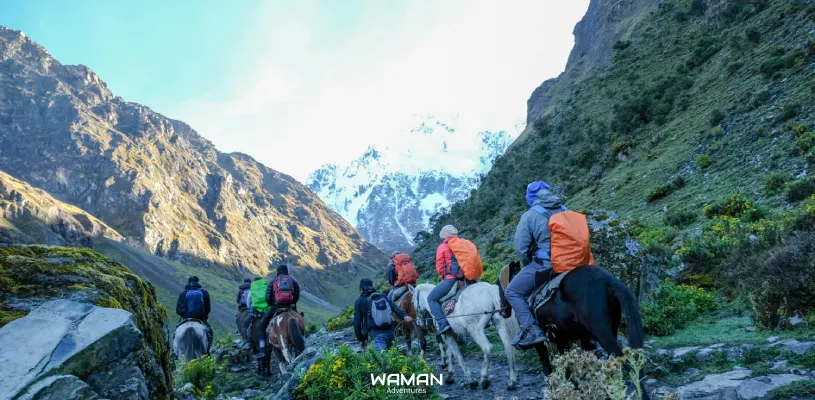
Trekkers climbing up to the Salkantay Pass
IS THE SALKANTAY TREK DANGEROUS?
The Salkantay trek is not dangerous as long as you take adequate precautions and preparation. However, like any outdoor and adventure activity, there are potential risks to consider:
- Geography: Steepy and rocky terrain makes the trek challenging and rough. It is recommended to be in good physical condition and use proper mountain gear.
- Altitude: The Salkantay trek reaches altitudes over 4600 m/15091 ft, especially at the Salkantay pass and the Incachiriaska pass (Salkantay + Inca Trail), so you may have problems with altitude sickness or soroche. For that reason is imperative to acclimatise properly before the trek begins.
- Weather conditions: The weather in Cusco and the Andes is unpredictable. Maybe a lot of chances of rain and cold temperatures exist especially in the rainy season. To be comfortable, wearing appropriate clothing and being prepared for weather changes are enough.
- Accidents: Being an outdoor activity, there is always the possibility of accidents such as sprains or falls over. Carrying a first aid kit can be useful.
- Altitude sickness: The Salkantay trek reaches altitudes over 4,630 m / 15,190 ft which can cause symptoms of altitude sickness such as headaches, fatigue and even breathlessness! In order to avoid it, proper acclimatisation is essential.
It is important to take these factors into account and take the necessary precautions to enjoy a safe and pleasant experience. For this reason, it is recommended that you hike the Salkantay trek with a trustworthy travel agency that knows the route well and can provide the necessary assistance in case of emergency.
HOW IS THE WEATHER ON THE SALKANTAY TREK?
The Salkantay trek weather varies according to the season and altitude along the route.
Here I provide information about weather conditions in different parts of the trek:
DRY SEASON
- The dry season runs from April to October.
- During these months, the weather is more stable and predictable.
- The average daytime temperature is 18 °C, whilst the average nighttime temperature is 2 °C.
- It is the most popular time to hike the Salkantay trek due to good weather conditions.
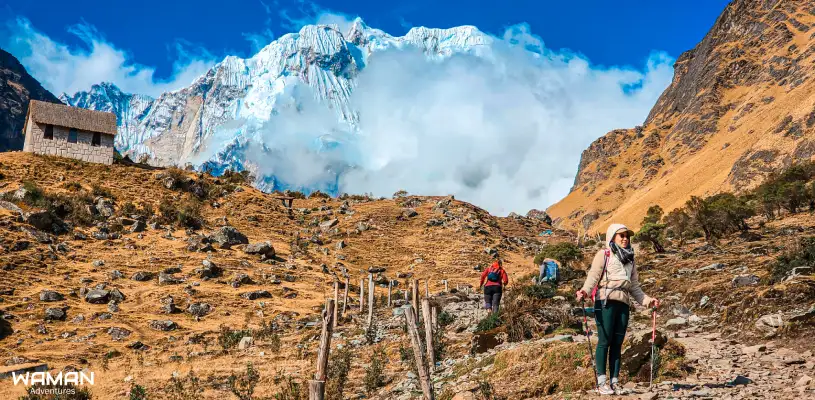
Hikers trekking the Salkantay trek in good weather – dry season
RAINY SEASON
- The rainy season runs from November to March.
- Rainfall is very common and heavier in high areas.
- The average daytime temperature is 16 °C, while the average nighttime temperature is 4 °C.
- This time of year may be less popular for trekking due to unfavourable weather conditions.

Hikers on the Salkantay train route in the rainy season
SALKANTAY TREK WEATHER AROUND THE YEAR
The Salkantay trek is a year-round experience, but you must consider its climatic conditions and seasonal variations.
SALKANTAY TREK IN JANUARY
The average temperature in the highlands during the day is 15 °C, while at night is 4 °C. However, in the cloud forest, daytime temperatures are around 20 °C.
- Advantages: Rainfalls last for a couple of hours, leaving behind beautiful rainbows, greener and blooming landscapes.
- Disadvantages: It’s the wettest month of the year complicating the Salkantay trek due to muddy trails. Nights can be frozen due to the altitude.
SALKANTAY HIKE IN FEBRUARY
This month is cold and rainy, and temperatures at higher elevations reach 15°C during the day and 4°C at night. At lower altitudes, daytime temperatures average 20 °C, while at night is 8 °C.
- Advantages: Very few adventurers choose this month. It is the least crowded month of the year.
- Disadvantages: Rainfall is heavier and more persistent making the trail very slippery and cloudy. Night temperatures are low in higher altitudes.
SALKANTAY TREK IN MARCH
The average daytime temperature at high altitude is 16 °C, while the average nighttime temperature is 3 °C. On the other hand, temperatures in the cloud forest average 21 °C, and 8 °C at night.
- Advantages: Rainfall usually decreases allowing travellers to venture out in the Salkantay trek. There are still fewer tourists compared to the high season. It marks the end of the rainy season.
- Disadvantages: The trail is still muddy and landslides are possible.
SALKANTAY HIKE IN APRIL
During the day, temperatures average around 17 °C in the higher elevations, with nights dropping to 3 °C. In the tropical zone, daytime temperatures reach 21°C, with nights averaging 6°C.
- Advantages: This month marks the start of the dry season, making it a good time to visit.
- Disadvantages: The Holly Season is celebrated in April which increases tourism and prices increase. Booking in advance is recommended.
SALKANTAY TREK IN MAY
Higher areas of the Salkantay trek have an average temperature of 17 °C during the day, but 2 °C at night. In the cloud forest, the daytime temperature is 21 °C and the nights are humid, with temperatures averaging 6 °C.
- Advantages: Days are warmer with sunny mornings and starry nights.
- Disadvantages: Tourism increases constantly, so booking ahead is recommended.
SALKANTAY TRAIL IN JUNE
In this month the famous “Festivity of Inti Raymi” takes place in Cusco city and outskirts. During this month, the average temperature in the highest areas of the Salkantay trek reaches 16 °C during the day, with quite cold nights of -2 °C. In the cloud forest, the average temperature ranges from 21 °C to 7 °C.
- Pros: Offers spectacular sunrises and mostly sunny days with clear blue skies, making it an ideal month to hike its trails.
- Cons: You should worry about solar radiation, so sunscreen and a hat are recommended.
SALKANTAY TREK IN JULY
This is one of the best months for the Salkantay trek. However, the average temperature in Puna areas reaches 16 °C, whereas at night it drops to -2 °C. In the cloud forest, the temperature reaches 20°C during the day and drops to 7°C at night.
- Pros: The weather is favourable for trekking everywhere. Also, it shows just blue skies, higher prices, and creamy landscapes.
- Cons: It’s the most crowded month in Cusco due to the high season of tourism, especially in Machu Picchu. Additionally, Peruvian holidays are celebrated this month, increasing tourist numbers in Cusco.
SALKANTAY TRAIL IN AUGUST
In August, during the day, the high areas of the Salkantay trail have an average temperature of 16 °C and at night it drops to 2 °C. In the tropical zone, daytime temperatures are around 20 °C, while night temperatures average 7 °C.
- Pros: August is the high season in Peru. Also, this month has a good climate.
- Cons: Be prepared for unexpected rains and cold nights.
SALKANTAY TREK IN SEPTEMBER
During this month the average daytime temperature in the higher areas of the Salkantay trail is 16 °C and at night it drops up to 4 °C. In the tropical zone, daytime temperatures are around 20 °C, while at night they average 8 °C.
- Pros: In this month, spring begins which means that the rains are more frequent but brief and then the sun comes out again.
- Cons: The rainy season begins this month.
SALKANTAY TREK IN OCTOBER
Puna areas on the Salkantay Trail, daytime temperatures rise up to 17 °C and drop up to 4 °C at night. In the cloud forest, daytime temperatures reach 21 °C, and they drop to 8 °C at night.
- Pros: October marks the end of the dry season, so it’s the last month you can make this trek without weather complications.
- Cons: Rainfall is often unpredictable making the trek slippery. Do not forget to pack your rain poncho.
SALKANTAY TRAIL IN NOVEMBER
In the Puna areas of the Salkantay trail, daytime temperatures rise around 16 °C, while nights are cooler, dropping 3 °C. At lower altitudes, temperatures average around 20 °C, while at night they average 9 °C.
- Pros: The tourist number is less which makes it an ideal time to enjoy the Salkantay Trail Peru with fewer crowds than in the summer months.
- Cons: The rainy season begins, which means wet and slippery trails.
SALKANTAY TREK IN DECEMBER
The temperature in Puna reaches around 16 °C, while nights are cooler, dropping up to 3 °C. In the cloud forest, daytime temperatures hover around 20 °C, while at night they drop up to 8 °C.
- Pros: The weather is warm and the trek offers picturesque views of landscapes blooming due to the rains.
- Cons: Trails and camping areas can be muddy due to the rainy season. They also increase landslides along the Salkantay Trail.
WHEN IS THE BEST TIME TO DO THE SALKANTAY TREK?
Undoubtedly, the optimum time is during the dry season, from April to October, because the weather in these months is more stable, showing less rainfall that could be more pleasant whilst trekking.
The trails are dry and in better condition whereas the muddy ones in the rainy season. A muddy trail means an easier trekking time. Also, clear blue skies are common, allowing you to witness stunning panoramic landscapes and surroundings along the Salkantay Trail.
IS THE SALKANTAY TREK WORTH IT?
Yes, the Salkantay trek is definitely worth it! If you don´t like hiking or outdoor activities, it would be better to spend your money elsewhere.
Here are some reasons why the Salkantay Trek to Machu Picchu is worth doing:
- The trek takes you through a variety of spectacular landscapes, from the snow-capped Salkantay Mountains, subtropical jungle areas in Machu Picchu, turquoise lakes and Inca trails and places; all of them are combined in just one stunning trekking experience.
- The trek offers tough challenges, such as crossing the Salkantay Pass, which are rewarding for trekking and adventure lovers.
- Throughout the trek, the opportunities to interact with local communities and learn about their culture, adding another point of view, are present.
- The Salkantay trek ends by exploring Machu Picchu, one of the modern world’s archaeological wonders. It means that the Salkantay Trek to Machu Picchu combines cultural and natural needs.
- Being the second trekking option after the Inca Trail, the Salkantay trek tends to be less crowded whereas the Inca Trail. It allows feeling a quiet experience in among the Andean nature.

Hikers hiking upwards the Salkantay Pass
HIGHLIGHTS OF THE SALKANTAY TREK TO MACHU PICCHU
Along the path is possible to natural resources because of its geography and location in the Andes. There are so many species of endemic birds along the route which pass silently. Here are some of the highlights trekking on the Salkantay Trail.
-
SNOW-CAPPED SALKANTAY MOUNTAIN
It’s located in the Vilcabamba Mountain Range, its height reaches 6,271 m/20554 ft above sea level. The first and second trekking days are ideal for observing it.
-
HUMANTAY LAKE
Nestled at 4,200 m/13779 ft! This lake is spectacular and has turquoise waters reflecting the majestic snow-capped mountain of the same name. Even though turquoise lakes are common in the high Andes, this is the most popular among others.
-
CHAULLAY
Chaullay is a quiet village bordered by mountains and thick forests. Here, you will be able to rest and meet the charming people that this route has to offer. In addition, there are campsites, restaurants, and other grocery stores nearby, making it a strategic location for hikers.
-
CLOUD FOREST
Cloud forest? Yes, once you trek down the Salkantay Pass, the cloud forest appears. Furthermore, this trek takes you through a variety of ecosystems and habitats, such as the cloud forest, which is one of them.
-
SANTA TERESA HOT SPRINGS
These pools are the most effective treatment for your tired body. It is located beside the Vilcanota River, near the hydroelectric plant.
-
MACHU PICCHU
Without a doubt, the highlight of the trek is Machu Picchu. This archaeological place is world famous for its impressive Inca architecture and location high in the Andes. Your expert guide will guide you through the area as you explore it.

Targets of the Salkantay Trek mentioned above
HOW TO BOOK THE SALKANTAY TREK?
You must book the Salkantay Trek ahead of time because you must ensure your Machu Picchu’s entrance tickets. Furthermore, if you are thinking about security, we recommend booking it with a travel agenty, and they also have to buy your entrance tickets if you take this option.
- Contact our sales agents to check your ideal date availability.
- If your desired date is available, we recommend that you make payment as soon as possible to secure your space.
HOW TO GET TO SALKANTAY TREK?
To get to the Salkantay trek starting point from the charming city of Cusco, you will have the option of taking a bus or minivan to the picturesque village of Mollepata, a journey that usually takes approximately 3 to 4 hours. From Mollepata you will be ready to start your exciting trek through the spectacular scenery of the Salkantay trek.
GETTING TO THE SALKANTAY TREK ON YOUR OWN
Getting to the Salkantay trek alone requires proper planning and several stages.
Here is a guide if you are planning to go by yourself:
- Arrive in Cusco: You have to arrive in Cusco city. You can get to Cusco by bus or plane, all leaving from Lima.
- Permits: You will need to buy an entrance ticket to Machu Picchu at least 2 months in advance, especially if you are travelling in the high season.
- Mountaineering equipment: Trekking equipment and mountain gear are required to trek these mountains. However, you can hire these items in Cusco.
- Route planning: Decide if you want to do the Salkantay trek on your own or in a group.
- Transport: You can take a VAN in Arcopata Street towards Mollepata or Soraypampa.
GETTING TO SALKANTAY TREK HIRING A TRAVEL AGENCY
- Planning: Research travel agencies in Cusco offering the Salkantay trek. You must consider itineraries, prices and reviews. Choose carefully for a well-planned trekking experience.
- Contact the agency: After choosing the agency, contact them by mail or phone to clarify doubts about dates, itinerary, prices and services of the Salkantay Trek to Machu Picchu. They must solve your doubts.
- Book your tour: Book your tour with your chosen agency. This may require a deposit or full payment, depending on their policies.
- Physical preparation and logistics: Prepare yourself physically improving your stamina. Check the necessary documentation to enter Peru before embarking on this adventure.
- Equipment and personal items: Prepare your equipment for the trek. Make sure you have suitable clothing and footwear, as well as a sturdy backpack and essential items such as a water bottle, sunscreen and a torch.
- Arrival in Cusco: Arrive in Cusco, which usually serves as the starting point for the Salkantay trek. Take some time to acclimatise to the altitude if necessary.
- Briefing: Your travel agency, such as Waman Adventures, will give you a briefing at least 2 days in advance. This meeting will provide you with information about the route and packing list.
- Start your adventure: Follow your guide’s instructions and enjoy the trek as you explore the breathtaking landscapes of the Vilcabamba Mountain Range.
- Enjoy and explore: Explore and take photographs of the majestic nature surrounding Salkantay Mountain. For the people who bring us together.
- Arrival in Machu Picchu: Finally, you will arrive at the marvellous Inca citadel of Machu Picchu. Enjoy your visit and admire this historic site before returning to Cusco.
Arriving at the Salkantay Trek with a travel agency provides you with an organised and comfortable experience, ensuring that you get the most out of this unforgettable adventure in Peru.
IS IT POSSIBLE TO DO THE SALKANTAY TREK WITHOUT A GUIDE?
Yes, you can do the Salkantay trek alone. However, careful planning and trekking experience are required. Also, be aware of the necessary permits and physical preparation.
REASONS WHY YOU SHOULD DO THE SALKANTAY TREK WITH A TRAVEL AGENCY
Why book the Salkantay trek with a travel agency?
Booking the Salkantay trek with a travel agency offers several advantages:
- Specialised travel agencies are experienced in planning and executing Salkantay treks because they know the logistical details, routes and appropriate safety practices.
- They manage the necessary permits for the trek and entry to Machu Picchu saving travellers time and effort.
- Agencies often provide expert local guides who know the area, culture and history, enriching the trekking experience.
- They provide camping equipment, and food.
- Although you do not need to reserve space for the Salkantay trek itself, booking with a travel agency guarantees your entry to Machu Picchu.
- They offer detailed information before the trek and constant guidance during the trek.
In addition, Waman Adventures offers you:
- Professional and experienced team. – Our highly trained team guarantees an unforgettable Salkantay Trek experience.
- Eco-friendly treks. – We value both nature and the local communities we visit.
- Door-to-door service. – Free transfer towards your hotel.
- Culinary delights on the trek. – Our chefs and cooks specialised in Andean cuisine will prepare exquisite meals in the open air, delighting you with authentic flavours.
- Comfortable camping equipment. – Your comfort is essential. We use Doite and Eureka tents.
- Good welfare. – We take deep care of our team’s well-being.
- Personalised group. – We prioritize quality over quantity.
IS TRAINING NECESSARY FOR THE SALKANTAY TREK? HOW TO TRAIN FOR THE SALKANTAY TREK?
Yes, it is highly recommended to train before the Salkantay trek. Although you don’t need to be a professional hiker, you should be in good physical condition to enjoy the trek and minimise the injury risk. Here are some tips to consider:
- Cardiovascular stamina: The trek involves high altitudes and challenging trails, so it is important to be in good cardiovascular condition. Take regular walks, jogs or bike rides to increase your cardiovascular endurance.
- Muscle strengthening: Strengthen your legs, especially the calf, thigh and buttock muscles, which are heavily used during walking. Do exercises such as squats, lunges and weight lifting.
- Altitude training: If possible, do workouts at higher altitudes you are familiar with.
- Practice hikes: Take shorter, steeper hikes on uneven terrain. This will help you improve your balance and get used to walking on challenging trails.
- Flexibility: Do stretching exercises to keep your muscles flexible and prevent injury.
- Hydration and nutrition: These are maybe the most essential things you must take care of whilst trekking and arriving in Cusco.

Training for the Salkantay Trek tour
HOW MUCH DOES IT COST TO DO THE SALKANTAY TREK?
The price of the Salkantay trek varies according to various factors such as season, tour agency, inclusions and schedule. Generally, the Salkantay trek costs between $ 500.00 and $ 800.00 per person.
It is essential to consider that this cost generally covers aspects such as transport, guides, accommodation in camps, meals and entrance to Machu Picchu. However, I would advise you to check with travel agencies or specialised tour providers for accurate and detailed information about the prices and services provided on the Salkantay Trek.
Here are the prices of the different Salkantay Trek versions from the WAMAN ADVENTURES agency:
TOUR PRICES – GROUP SERVICES
| TREKKING VERSION | N° OF HIKERS | PRICE PER PERSON | LET’S GO! |
| Salkantay Trek to Machu Picchu 5 days | 2 or more people | $589.00 USD | BOOK NOW! |
| Salkantay Tre to Machu Picchu 4 days | 2 or more people | $569.00 USD | BOOK NOW! |
TOUR PRICES – PRIVATE SERVICE
| TREKKING VERSION | N° OF HIKERS | PRICE PER PERSON | LET’S GO! |
| Salkantay Trek to Machu Picchu 5 days | 2 – 8 or more people | $780.00 – $ 630.00 USD | BOOK NOW! |
| Humantay Lake & Salkantay Pass 2 days | 2 – 9 or more people | $260.00 – $150.00 USD | BOOK NOW! |
PACKING LIST FOR THE SALKANTAY TREK
Here is our list of what to pack for the Salkantay trek to Machu Picchu:
ESSENTIALS
- Original physical passport.
- ISIC card (students).
- Extra money (soles).
- Water bottle or camelback.
- Personal medication.
- Sunscreen (SPF 50+).
- Hat.
- Sunglasses.
- Mosquito repellent.
- Personal care items.
CLOTHING
- Trekking or trail running shoes.
- Long sleeve T-shirts.
- Trekking pants (detachable).
- Waterproof jacket.
- Fleece jacket.
- Socks.
- Gloves.
- Fleece hat.
- Underwear.
- Rain poncho.
- Swimwear.
- Sandals.
EQUIPMENT
- Trekking poles.
- Sleeping bag.
- Duffle bag.
- Backpack day.
RECOMMENDED
- Waterproof dry bags.
- Power bank.
- Pain killers.
- Camera.
- Headlamp.
- Notepad and pen.
- Snacks (Nuts, electrolytes, energy bars).
- Light towels.
- Wet towels.
- Cash (soles).

Everything you need to take on the Salkantay Trail
WHAT TO WEAR ON THE SALKANTAY TREK TO MACHU PICCHU
Dressing appropriately for the Salkantay trail is essential to ensure a comfortable and safe experience. Here are some dressing guidelines for this trek:
- Layers of clothing: Start with a quick-drying T-shirt as a first layer, add a thermal or long-sleeved T-shirt as a second layer and finish with a waterproof, windproof jacket as a third layer.
- Breathable T-shirts: Opt for breathable materials that wick moisture and keep you dry during the trek.
- Detachable trekking pants: These are versatile, you can wear them as pants on cold mornings and convert them into shorts during the day if it’s hot.
- Waterproof jacket: It should be waterproof and windproof to protect you from rain and variable weather conditions, especially ascending towards Salkantay Pass.
- Fleece jacket: Fleece jackets keep you warm. It can be worn under waterproof jackets on cold days.
- Quick-drying shirts: These shirts wick away sweat and dry quickly, making them ideal as a first layer.
- Thermal trousers: These provide an extra layer of insulation to keep your legs warm.
- Trekking socks: These prevent blisters and keep your feet comfortable.
- Trekking or trail running shoes: They should be comfortable and support your feet. Hoka is good.
- Hat and sunglasses: A hat protects you from the sun and rain, and sunglasses protect your eyes from UV radiation.
- Trekking backpack: A sturdy backpack is necessary to carry your belongings, including water, food, extra clothing and other essentials.
- Trekking poles: Trekking poles provide stability and relieve stress on your joints.

Dressing appropriately is key to comfort and safety on the Salkantay trail.
FLORA AND FAUNA ON THE SALKANTAY TREK
Flora on the Salkantay Trek
- Queuña (Polylepis sp.): The queuña is a sturdy tree that thrives at high altitudes. Its twisted branches and rough bark are adaptations to the harsh conditions of the high mountains. This species is important for water conservation in Andean ecosystems.
- Bromeliads (Bromeliaceae): Bromeliads are ornamental plants that cling to trees or hang from them. Their leaves form a rosette that holds water, providing a habitat for small creatures like frogs and other insects. You will find a variety of bromeliad species in the Salkantay Trail cloud forest.
- Ferns (Cyathea sp.): Ferns are primitive plants that thrive in moist, shady environments. On the Salkantay Trail, you can see a diversity of ferns in the cloud forest, adding lush greenery to the landscape.
- Orchids: Orchids are famous for their beauty and diversity. In the cloud forests of the Salkantay Trek, you will find numerous species of orchids in different colours and shapes adding elegance to the flora of the region.
- Bamboo chusquea (Chusquea scandens): Andean bamboo is a hardy plant that forms dense thickets in mountainous areas. Its thin canes are used in house construction and other structures in local communities.
- Ichu (Stipa ichu): Ichu is a highland grass native to the Andes adapted to high altitudes. It is used as feed for livestock and contributes to soil formation in mountainous areas.

Flora on the Salkantay trail: Queuña, bromeliads, ferns, orchids, Andean bamboo, ichu.
Fauna of the Salkantay Trek to Machu Picchu
- Andean condor (Vultur gryphus): The Andean condor is one of the largest birds in the world and a symbol of the Andes. You can see it soaring majestically over the mountains. Its wings and imposing presence make it an impressive sight to watch.
- Andean Bear (Tremarctos ornatus): The spectacled bear is the only bear native to South America. Although elusive and rarely seen, its presence adds mystery to the region. It is known for its distinctive white face mark.
- Cock-of-the-rock (Rupicola peruvianus): The cock-of-the-rock is an elegant and vibrant bird and the national bird of Peru. Males have brightly coloured plumage and gather in leks for elaborate courtship displays.
- Woodpecker (Colaptes atricollis): Woodpeckers are well known for their ability to climb trees and search for insects. They are an integral part of the Andean forests and can be heard tapping into the trunk for food.
- Toucanet: The toucanet is a small toucan species that inhabits tropical and subtropical forests. Its striking beak and colours make it easy to identify among tree branches.
- Crested oriole (Psarocolius decumanus): This oriole is known for its elaborate hanging nests. Its black and yellow plumage makes it stand out in forests.
- Chachalaca (Ortalis cinereiceps): The chachalaca is a bird found in the forests and scrub areas of the region. Its distinctive call is often heard at dawn and dusk.

Andean condor, Andean spectacled bear, Cock-of-the-Rock, Woodpecker, Toucanet, Crested Oropendola and Speckled Chachalaca.
Are you an adventurer seeking unique experiences? The Salkantay trek is your ideal adventure in the Peruvian Andes. Escape the crowds and immerse yourself in the authenticity of the Andes Mountain Range, where the majesty of the mountains meets the lushness of the rainforest.
Explore breathtaking landscapes and connect deeply with nature and culture along the Salkantay Trek to Machu Picchu. Named among the top 25 treks in the world by National Geographic Adventures Travel, the Salkantay Trail offers an exceptional experience.
Dare to live an unforgettable trek with Waman Adventures and discover Peru’s best-kept treasures as you approach Machu Picchu! Book your Salkantay trek now and experience the thrill at every step.


